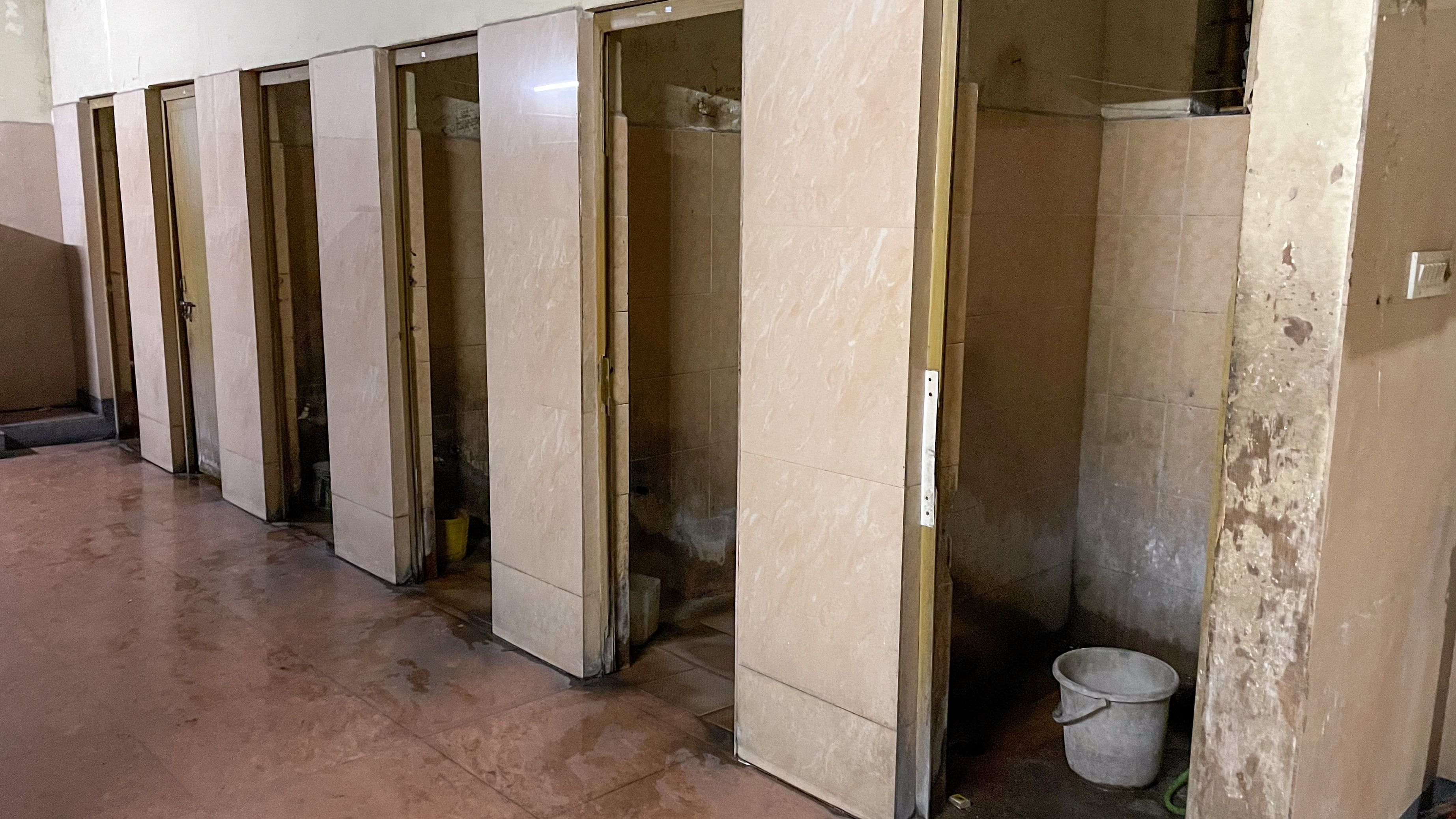
The public toilet at Kengeri Bus Stand on Saturday.
Credit: DH Photo/Pushkar V
Bus stations in the city are more than just transit points; they’re safe havens for travellers seeking rest before continuing their journeys. With their constant high footfall, especially during holidays and festive seasons, their maintenance becomes crucial. This responsibility often falls on the shoulders of transport corporations or outsourced agencies.
However, a reality check by DH paints a grim picture of neglect in these bustling hubs. Despite the Bengaluru Metropolitan Transport Corporation (BMTC) outsourcing the upkeep of essential facilities like pay-and-use toilets, waiting rooms, and feeding rooms, the reality starkly contrasts with their intended purpose. A week-long review of five such bus stations reveals a distressing state of disrepair.
The findings are alarming: toilets are unusable, broken, or dysfunctional; sinks and floors are stained; and a pervasive, unbearable stench looms over these spaces. This deterioration not only mars the city’s image but also raises significant concerns about the health and comfort of thousands of daily commuters. As these stations continue to see a surge in visitors, the glaring gap between the responsibility of maintenance and its execution stands as a challenge that demands immediate attention and action.
Shivajinagar bus station
In Shivajinagar bus station, the “Mother’s Lounge” – a space dedicated to providing comfort and privacy for mothers and their children – falls short of its intended purpose. A recent visit revealed that out of four sinks in the lounge, only one was functional, and none were clean. This lack of basic hygiene is compounded by the fact that the feeding room, an essential part of the lounge, lacks both lighting and seating, making it difficult for mothers to care for their infants comfortably. The room’s floor, cluttered with cement and sand, further adds to the unwelcoming environment. Adding to the inconvenience, staff members stationed outside the washrooms charge a usage fee of Rs 10, yet the conditions inside are far from satisfactory. While the toilets are usable, the Western-style ones suffer from a non-functional flush system.
“Sometimes the sinks are stained with paan and used sanitary pads are stuffed in the gaps of the ventilator window,” said Shreya Nandakumar, a student travelling to Richmond Circle every day. She refrains from using the toilet.
Kengeri TTMC
The waiting room, constructed under the Nirbhaya scheme and primarily used by pregnant women and feeding mothers, is open 24/7. However, the toilets are soiled. Despite the presence of a signboard prohibiting men’s entry, some male conductors were observed using the room’s water purifier. In the women’s washroom, none of the sinks were operational, and the toilets were poorly maintained and dysfunctional; one did not even have a lock. The condition of the men’s washroom was similarly poor.
“The stench in the men’s washroom makes it close to impossible to use,” said Vinay, a regular passenger. He highlighted faulty pipe connections and clogged urinals as additional issues and suggested that the washrooms should be cleaned twice a day.
Kempegowda bus station, Majestic
Although the four Indian-style toilets in the pay-and-use women’s washroom were clean, one of the stalls did not have a lock while the edges of the commodes were cracked. Similarly, the waiting room seemed well-maintained but the toilet inside was clogged and had an unusable flush. A woman conductor who came to use the washroom suggested using the pay-and-use toilets instead of the one in the waiting room. Passengers who used the men’s washroom complained of the intolerable stench and poor maintenance.
Shanthinagar TTMC
The toilet in the waiting room was locked, and of the four stalls in one of the two washrooms, only one was functional. Workers are not provided with masks and gloves and must purchase them on their own if needed. The washroom lacked sanitary vending machines and tissues, and none of the toilet stalls had dustbins. Although workers and staff assured that the washroom was cleaned twice daily, the poor condition of the toilets deterred passengers from using them frequently.
Kalasipalya TTMC
There is no waiting room at this station. The women’s washroom, equipped with just one common dustbin, often leads users to dispose of used diapers and pads in the toilets. Out of five toilets, only three are functional, and just one of the four sinks works. The flushes in the Indian-style toilets are all non-operational. While BMTC staff can use the washrooms for free, passengers are charged Rs 5. The guards refused to respond to questions regarding the maintenance of the washrooms.
“When passengers complain about guards charging more than the fixed price, we warn the guards immediately,” said Shamoon Pasha, the traffic controller, who said that the toilets were cleaned once a day.
A toilet lacking a flush tank at Kalasipalyam TTMC.
Credit: DH Photo/ Flora Adeline
Tenders to be called soon
A senior BMTC official said that tenders are periodically called once in three years to select a housekeeping agency to maintain different stations including cleaning the toilets. Tender documents at times only mention the requirements and area to be maintained while other times specify the number of staff required for maintenance which ranges from 10 to 12 people per shift depending on the area of the station. Within the next month housekeeping tenders will be called for some of the bigger stations such as Kalasipalya Shanthinagar and Majestic.